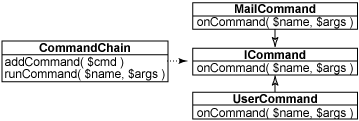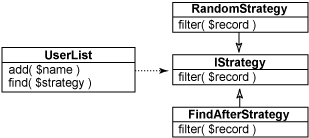
The book Design Patterns introduced design patterns to the software community. The authors of the book are Erich Gamma, Richard Helm, Ralph Johnson, and John Vlissides Design (commonly known as the "Gang of Four"). The core concepts behind the design patterns presented are very simple. After years of practicing software development, Gamma and others have discovered certain patterns with fixed designs, much like architects design houses and buildings, developing templates for where a bathroom should be or how a kitchen should be constructed. Using these templates, or design patterns, means designing better buildings faster. The same concept applies to software.
Design patterns not only represent a useful way to develop robust software faster, but they also provide a way to encapsulate large ideas in friendly terms. For example, you could say that you are writing a messaging system that provides loose coupling, or you could say that you are writing a pattern named Observer.
It is very difficult to demonstrate the value of patterns with smaller examples. This often feels like overkill, since patterns actually work in large code bases. This article does not demonstrate a large application, so you need to think about ways to apply the principles of the example in your own large application—not the code itself demonstrated in this article. This is not to say that you shouldn't use patterns in small applications. Many good applications start out as small applications and progress to large applications, so there's no reason not to build on these types of solid coding practices.
Now that you understand design patterns and why they are useful, let’s take a look at the five commonly used patterns in PHP V5.
Originally in the book Design Patterns, many design patterns encourage the use of loose coupling. To understand this concept, it's best to talk about the arduous journey that many developers go through working on large systems. Problems occur when one piece of code is changed, and the rest of the system — It’s possible for cascading damage to occur in parts you once thought were completely unrelated.
The problem lies in tight coupling. Functions and classes in one part of the system are heavily dependent on the behavior and structure of functions and classes in other parts of the system. You want a set of patterns that allow these classes to communicate with each other, but you don't want to tie them tightly together to avoid interlocking.
In large systems, a lot of code depends on a few key classes. Difficulties may arise when these classes need to be changed. For example, suppose you have a User class that reads from a file. You want to change it to a different class that reads from the database, however, all your code references the original class that reads from the file. At this time, it will be very convenient to use factory mode.
Factory pattern is a class that has certain methods that create objects for you. You can use a factory class to create objects instead of using new directly. This way, if you want to change the type of object created, you only need to change the factory. All code using this factory is automatically changed.
Listing 1 shows an example of the factory class. The server side of the equation consists of two parts: a database and a set of PHP pages that allow you to add feedback, request a list of feedback, and get articles related to a specific feedback.
| < | % php factory1.php Jack % |
测试代码会向工厂请求 User 对象,并输出 getName 方法的结果。
有一种工厂模式的变体使用工厂方法。类中的这些公共静态方法构造该类型的对象。如果创建此类型的对象非常重要,此方法非常有用。例如,假设您需要先创建对象,然后设置许多属性。此版本的工厂模式会将该进程封装在单个位置中,这样,不用复制复杂的初始化代码,也不必将复制好的代码在在代码库中到处粘贴。
清单 2 显示使用工厂方法的一个示例。
| < | <?php
interface
IUser
{
function
getName();
}
class
User implements IUser
{
public
static function Load( $id )
{
return
new User( $id );
}
public
static function Create( )
{
return
new User( null );
}
public
function __construct( $id ) { }
public
function getName()
{
return
"Jack";
}
}
$uo= User::Load(
1 );
echo(
$uo->getName()."\n" );
?>Copy after login |
这段代码要简单得多。它仅有一个接口 IUser 和一个实现此接口的 User 类。User 类有两个创建对象的静态方法。此关系可用图 2 中的 UML 表示。

在命令行中运行脚本产生的结果与清单 1 的结果相同,如下所示:
1 2 3 | % php factory2.php Jack % Copy after login |
如上所述,有时此类模式在规模较小的环境中似乎有些大材小用。不过,最好还是学习这种扎实的编码形式,以便应用于任意规模的项目中。
某些应用程序资源是独占的,因为有且只有一个此类型的资源。例如,通过数据库句柄到数据库的连接是独占的。您希望在应用程序中共享数据库句柄,因为在保持连接打开或关闭时,它是一种开销,在获取单个页面的过程中更是如此。
单元素模式可以满足此要求。如果应用程序每次包含且仅包含一个对象,那么这个对象就是一个单元素(Singleton)。清单 3 中的代码显示了 PHP V5 中的一个Sharing common PHP design patterns。
<?php
require_once("DB.php");
class
DatabaseConnection
{
public
static function get()
{
static
$db= null;
if
( $db == null )
$db= newDatabaseConnection();
return
$db;
}
private
$_handle= null;
private
function __construct()
{
$dsn= 'mysql://root:password@localhost/photos';
$this->_handle
=& DB::Connect( $dsn, array() );
}
public
function handle()
{
return
$this->_handle;
}
}
print(
"Handle = ".DatabaseConnection::get()->handle()."\n" );
print(
"Handle = ".DatabaseConnection::get()->handle()."\n" );
?>Copy after login |
此代码显示名为 DatabaseConnection 的单个类。您不能创建自已的 DatabaseConnection,因为构造函数是专用的。但使用静态 get 方法,您可以获得且仅获得一个 DatabaseConnection 对象。此代码的 UML 如图 3 所示。

在两次调用间,handle 方法返回的数据库句柄是相同的,这就是最好的证明。您可以在命令行中运行代码来观察这一点。
% php singleton.php Handle = Object id #3 Handle = Object id #3 % Copy after login |
返回的两个句柄是同一对象。如果您在整个应用程序中使用Sharing common PHP design patterns,那么就可以在任何地方重用同一句柄。
您可以使用全局变量存储数据库句柄,但是,该方法仅适用于较小的应用程序。在较大的应用程序中,应避免使用全局变量,并使用对象和方法访问资源。
观察者模式为您提供了避免组件之间紧密耦合的另一种方法。该模式非常简单:一个对象通过添加一个方法(该方法允许另一个对象,即观察者 注册自己)使本身变得可观察。当可观察的对象更改时,它会将消息发送到已注册的观察者。这些观察者使用该信息执行的操作与可观察的对象无关。结果是对象可以相互对话,而不必了解原因。
一个简单示例是系统中的用户列表。清单 4 中的代码显示一个用户列表,添加用户时,它将发送出一条消息。添加用户时,通过发送消息的日志观察者可以观察此列表。
<?php
interface
IObserver
{
function
onChanged( $sender, $args );
}
interface
IObservable
{
function
addObserver( $observer );
}
class
UserList implements IObservable
{
private
$_observers= array();
public
function addCustomer( $name )
{
foreach(
$this->_observers as $obs )
$obs->onChanged(
$this, $name );
}
public
function addObserver( $observer )
{
$this->_observers
[]= $observer;
}
}
class
UserListLogger implements IObserver
{
public
function onChanged( $sender, $args )
{
echo(
"'$args' added to user list\n" );
}
}
$ul
= new UserList();
$ul->addObserver(
new UserListLogger() );
$ul->addCustomer(
"Jack" );
?>Copy after login |
此代码定义四个元素:两个接口和两个类。IObservable 接口定义可以被观察的对象,UserList 实现该接口,以便将本身注册为可观察。IObserver 列表定义要通过怎样的方法才能成为观察者,UserListLogger 实现 IObserver 接口。图 4 的 UML 中展示了这些元素。

如果在命令行中运行它,您将看到以下输出:
% php observer.php 'Jack' added to user list % Copy after login |
测试代码创建 UserList,并将 UserListLogger 观察者添加到其中。然后添加一个消费者,并将这一更改通知 UserListLogger。
认识到 UserList 不知道日志程序将执行什么操作很关键。可能存在一个或多个执行其他操作的侦听程序。例如,您可能有一个向新用户发送消息的观察者,欢迎新用户使用该系统。这种方法的价值在于 UserList 忽略所有依赖它的对象,它主要关注在列表更改时维护用户列表并发送消息这一工作。
此模式不限于内存中的对象。它是在较大的应用程序中使用的数据库驱动的消息查询系统的基础。
命令链 模式以松散耦合主题为基础,发送消息、命令和请求,或通过一组处理程序发送任意内容。每个处理程序都会自行判断自己能否处理请求。如果可以,该请求被处理,进程停止。您可以为系统添加或移除处理程序,而不影响其他处理程序。清单 5 显示了此模式的一个示例。
<?php
interface
ICommand
{
function
onCommand( $name, $args );
}
class
CommandChain
{
private
$_commands= array();
public
function addCommand( $cmd )
{
$this->_commands
[]= $cmd;
}
public
function runCommand( $name, $args )
{
foreach(
$this->_commands as $cmd )
{
if
( $cmd->onCommand( $name, $args ) )
return;
}
}
}
class
UserCommand implements ICommand
{
public
function onCommand( $name, $args )
{
if
( $name != 'addUser' ) return false;
echo(
"UserCommand handling 'addUser'\n" );
return
true;
}
}
class
MailCommand implements ICommand
{
public
function onCommand( $name, $args )
{
if
( $name != 'mail' ) return false;
echo(
"MailCommand handling 'mail'\n" );
return
true;
}
}
$cc
= new CommandChain();
$cc->addCommand(
new UserCommand() );
$cc->addCommand(
new MailCommand() );
$cc->runCommand(
'addUser', null );
$cc->runCommand(
'mail', null );
?>Copy after login |
This code defines the CommandChain class that maintains a list of ICommand objects. Both classes can implement the ICommand interface - One responds to requests for emails, and the other responds to adding users. Figure 5 shows the UML.

#If you run a script that contains some test code, you will get the following output:
% php chain.php UserCommand handling 'addUser' MailCommand handling 'mail' % |
代码首先创建 CommandChain 对象,并为它添加两个命令对象的实例。然后运行两个命令以查看谁对这些命令作出了响应。如果命令的名称匹配 UserCommand 或 MailCommand,则代码失败,不发生任何操作。
为处理请求而创建可扩展的架构时,命令链模式很有价值,使用它可以解决许多问题。
我们讲述的最后一个设计模式是策略 模式。在此模式中,算法是从复杂类提取的,因而可以方便地替换。例如,如果要更改搜索引擎中排列页的方法,则策略模式是一个不错的选择。思考一下搜索引擎的几个部分 —— 一部分遍历页面,一部分对每页排列,另一部分基于排列的结果排序。在复杂的示例中,这些部分都在同一个类中。通过使用策略模式,您可将排列部分放入另一个类中,以便更改页排列的方式,而不影响搜索引擎的其余代码。
作为一个较简单的示例,清单 6 显示了一个用户列表类,它提供了一个根据一组即插即用的策略查找一组用户的方法。
<?phpinterface
IStrategy{ function
filter( $record );} class
FindAfterStrategy implements IStrategy{ private
$_name; public
function __construct( $name ) { $this->_name
= $name; } public
function filter( $record ) { return
strcmp( $this->_name, $record ) <= 0; }} class
RandomStrategy implements IStrategy{ public
function filter( $record ) { return
rand( 0, 1 ) >= 0.5; }} class
UserList{ private
$_list = array(); public
function __construct( $names ) { if
( $names != null ) { foreach(
$names as $name ) { $this->_list
[]= $name; } } } public
function add( $name ) { $this->_list
[]= $name; } public
function find( $filter ) { $recs
= array(); foreach(
$this->_list as $user ) { if
( $filter->filter( $user ) ) $recs
[]= $user; } return
$recs; }} $ul
= new UserList( array( "Andy", "Jack", "Lori", "Megan" ) );$f1
= $ul->find( new FindAfterStrategy( "J" ) );print_r(
$f1 ); $f2
= $ul->find( new RandomStrategy() );print_r(
$f2 );?>此代码的 UML 如图 6 所示。

UserList 类是打包名称数组的一个包装器。它实现 find 方法,该方法利用几个策略之一来选择这些名称的子集。这些策略由 IStrategy 接口定义,该接口有两个实现:一个随机选择用户,另一个根据指定名称选择其后的所有名称。运行测试代码时,将得到以下输出:
% php strategy.phpArray( [0] => Jack [1] => Lori [2] => Megan)Array( [0] => Andy [1] => Megan)%
测试代码为两个策略运行同一用户列表,并显示结果。在第一种情况中,策略查找排列在 J 后的任何名称,所以您将得到 Jack、Lori 和 Megan。第二个策略随机选取名称,每次会产生不同的结果。在这种情况下,结果为 Andy 和 Megan。
策略模式非常适合复杂数据管理系统或数据处理系统,二者在数据筛选、搜索或处理的方式方面需要较高的灵活性。
本文介绍的仅仅是 PHP 应用程序中使用的几种最常见的设计模式。在设计模式 一书中演示了更多的设计模式。不要因架构的神秘性而放弃。模式是一种绝妙的理念,适用于任何编程语言、任何技能水平。
The above is the detailed content of Sharing common PHP design patterns. For more information, please follow other related articles on the PHP Chinese website!




